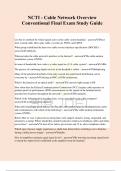What is Solution- Focused Brief Therapy?
The basics of SFBT
Team approach
Steve de Shazar and Insoo Kim Berg cultivated a culture of opennes to learn new ways to
discover clients’ ability to solve their own problems and professionals’ opennes to learn
from clients with infinite respect for their integrity and professional curiosity, tempered with
“a not-knowing” posture.
Exceptions to the Problem
- almost every problem contains an element of solutions exceptions to problems:
includes the times when even the most depressed person experiences a bit of relief
from oppressive depression. These are times when the problem could have occurred,
but it did not or it was less severe than usual.
- By studying these small pieces of relief, the motivated client was able to extent this
small segment of solutions to bigger and wider areas.
- Almost all problems contain exceptions.
- SFBT emphasizes that the problem is not a fixed entity but a changeable, negotiable
item that is dependent on social contexts.
- There is no causal relationship between problems and solutions.
SFBT versus traditional play therapy
Traditional Play SFBT
Based on assumption that it’s helpful to act The therapeutic work is very much focused
out feeling of anger, frustration, aggression on the client’s real life outside of the
etc. therapy room.
Long-term relationship with therapist. Short-term relationship with therapist.
Children encouraged to regress emotionally By paying attention to the skills and abilities
so that they can start rebuilding different they already have, the therapist can
, behavioral patterns and develop new skills. uncover and build on them.
Play is used as a diagnostic tool to Therapist’s role it to make the child’s
determine the child’s deficits and the steps strengths, competencies, and abilities more
to be taken in a long-term relationship evident to the child en to involved parents.
between child and therapist.
Parents are not invovled in therapeutic Parent are involved.
activities. Only a supportive role.
Problem solving assumptions and procedures
- The most commonly used and accepted way of solving problems can be thought of
as a scientific or “cause and effect” approach: “problem-solving” approach.
- Traditional problem solving practice begins with assesing the problem to determine
its cause. Direct relationship between a problem and its cause; problem-solving
involves finding and fixing the cause.
- Works well when problems are simple, mechanical, and routine.
- When no direct relationship can be pinpointed, a situation is often considered
mysterious, and consequently no one is sure what to do about it.
- Major difficulty is that a simple problem involves human factors that differ from child
to child, household to household, parent to parent, and school to school.
- More complicated problems may require more involved solutions:
Step 1: lengthy investigation of the problems by learning the history of the
onset of symptoms, any possible family history, and detailed description of
problematic symptoms.
Step 2: speculate on the root causes of the problem (making sense of where
the problem may have originated, and what might be the immediate and
long-term causal factors).
Step 3: finding a proper solution to the problem.
Step 4: professionals prescribe what the solutions to the client’s problems
might be.
Thinking out of the box
SFBT is “leading from one-step behind”
, 1. SFBT begins with an assessment of possible solutions, that is, the outcome that the
client expects and desires.
2. During this assessment phase the therapist can learn a great deal about the client’s
talents and skills and how the individual came to develop them.
3. From this, the therapist learns how to use those abilities to arrive at solutions.
4. Then the therapist begins learning how to assist the client in repeating past and
present successes until the desired level of satisfaction is reached.
Cultural competence
When the topic of cultural diversity is introduced among professionals it usually means
emphasizing what differentiates and seperated one ehtnic culture from that of the
mainstream. We worry that such emphasis on differences may result in a negative outcome
and may even become a disservice to the families themselves, and practitioners who must
serve these families. We think such an approach is not only divisive but also tends to focus
on a narrow view of ethnicity, thereby unintentionally stereotyping and categorizing families
of different ethnic backgrounds.
- SFBT Instead of viewing ourselves as experts on different cultures, we view and
respect clients as experts of their own ways of doing things. In addition, rather on
focusing on differences between therapist and client, we focus on similarities
(contributes to a sense of unity)
Not knowing postures
- View clients as experts of their own situations and solutions to their difficulties.
- Willingness to learn from clients is even more crucial when working with ethnic
families asking what the client’s view of solutions might be as well as ways to
implement the procedures.
Ways to work with Parent and Teenagers in Ethnic Families
- When parents’ hopes and dreams for their children’s successful future are located in
the new environment, it is easier to negotiate goals to narrow the gap between
generations (parents and adolescents share the same dreams and future aspirations).
, - This gap in aspirations and values seems to widen for those parents who see
themselves returning to their country of origin (for these children it is difficult to
comprehend or entertain the same reams as their parents).
Brief Contacts
- Most ethnic families are interested in concrete services that will benefit them
immediately, not in weeks or months (“not psychologically minded”).
- Perfect candidates for brief therapy.
- Therefore, when meeting with ethnic parents, finding out their indicators for
successful treatment outcome is important.
Chapter 2
Solution-Focused Brief Therapy and Children: A natural fit
Learning Children’s Ways
Children do not have fully developed language skills, they communicate with body
movements, looks, imaginations, fantasy, and many other creative ways. Therefore, working
with children requires different ways of observing and listening. Underlying principle is to
listen to them, to learn how unique each child is, and how each one makes sense of the
world in a unique way. The more respectful we are of these characteristics, the more we will
empower children to discover their own personalities and to thrive as individuals. We
believe there is good harmony between SFBT and children because there are so many
similarities between how children think and make sense of the world around them and the
assumptions and procedures of SFBT (e.g. children rarely need to know what causes a
problem). Close observation shows that children solve through trial and error
Children as Involuntary Clients
- All children’s problems are defined by adults.
- They have no idea what a counselor or therapist does.
- Before a child begins therapy, it is important to explain what will happen every step
of the way.











